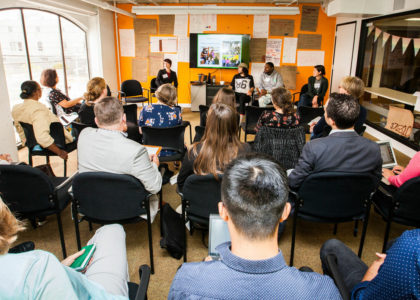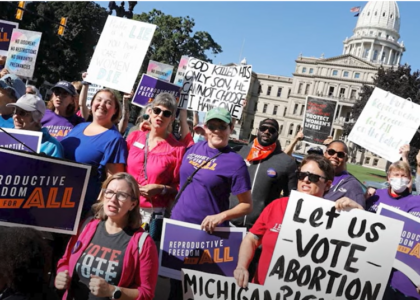Embracing Trust-Based Philanthropy: An Interview with Dropbox Foundation and KIND
June 13, 2023

As part of Rockefeller Philanthropy Advisors’ new mission and values, we are featuring in-depth profiles of our clients to highlight their work in creating a just world. RPA Senior Advisor, Tina Joh, spoke with Tina Lee of Dropbox Foundation and Hannah Chotiner-Gardner of Kids in Need of Defense (KIND). Dropbox Foundation focuses on human rights work, and KIND is a grantee of Dropbox. The conversation focused on Dropbox’s approach to grantmaking, the work they are facilitating at KIND, and the importance of trust-based philanthropy. This interview reflects edits for length and clarity.
Tina Joh:
Welcome, Tina Lee and Hannah Chotiner- Gardner. Thank you so much for sitting down with me to talk about Dropbox Foundation and its approach to grant-making. Before we dive into questions, I’d like to ask each of you to introduce yourselves.
Tina Lee:
Thank you for this opportunity. My name is Tina Lee, and I head up the Social Impact and Sustainability team at Dropbox, which includes managing the Dropbox Foundation. Dropbox Foundation is our corporate philanthropic grant-making vehicle that builds, and fosters relationships with nonprofits around the world focused on human rights. I also lead our employee engagement function, as well as our sustainability ESG programmatic work.
Hannah Chotiner-Gardner:
I am Hannah Chotiner-Gardner, the Chief Development Officer at Kids in Need of Defense (KIND). Our mission is straightforward: we envision a world where children’s rights and wellbeing are protected as they migrate in search of safety. We provide legal representation to unaccompanied and separated children, as well as social services. We conduct policy and advocacy to support laws and policies that protect children and their wellbeing. And we work internationally to support children and families as they migrate in search of safety. We are working in Mexico and Central America and have a growing presence in Europe, especially in the last year since the war in Ukraine started.
Tina Joh:
Thank you. We all come to our work with our unique personal and professional backgrounds. Would you please discuss how your background influenced your current work?
Tina Lee:
Before coming to Dropbox I spent most of my career in the nonprofit world. I worked in philanthropy for over a dozen years with private and family foundations, thinking about strategic philanthropic giving. I then moved over to working with technology companies, thinking about how they operate in the space and how they can use their technology for good. That is when I moved to Dropbox with my first in-house role. For so long I was a fundraiser, but now I have the perspective and responsibility of being on the funder side.
Thinking from a funder lens, I need to ask myself how we make sure the funds and support we can give to nonprofits are best utilized and leveraged by those organizations. They are the experts in the space. Building that partnership and trust-based philanthropy is my job, and I love it. The experience I’ve had working in nonprofits has helped me position myself to think effectively as a corporate funder, considering the different stakeholders and how they are able to take our support and further their mission.
Hannah Chotiner-Gardner:
I have worked in nonprofits for my entire career. I believe that the measure of a person is how they treat the most vulnerable and those most in need. Working to protect kids who are often marginalized and not seen or heard is a privilege I take very seriously. I decided to make my career in fundraising because it is the lifeblood for all the organizations whose work I value; every mission driven organization needs financial resources to fuel their work. Ensuring that worthy organizations such as KIND have the money they need is my way of contributing, just like our dedicated program staff who work with our clients every day, caring for them, supporting them, and helping them build safe and productive futures.
Tina Joh:
You’ve both talked about the values that drive you in your lives and your work. That is a good segue because I want to talk about trust-based philanthropy and how taking a trust-based approach is a values-based approach. What I love about your foundation, Tina Lee, is that you all adopted a trust-based approach from the get-go. This was before the concept had gained the traction that we’ve seen recently. Why did the foundation decide to take this approach and what does trust-based giving mean to you?
Tina Lee:
Since its launch in 2016, Dropbox Foundation has supported human rights organizations around the world through unrestricted grants, skills-based volunteering, and product donation over a three-year partnership with each grantee. The Foundation was funded jointly by Dropbox and its two co-founders, Drew Houston and Arash Ferdowsi. At the inception, we had this great opportunity to build from scratch and decide what we wanted this vehicle to look like. We surveyed around, trying to identify some of the areas that our corporate tech peers were not currently able to address or support. Every decision we made was based on trying to create the largest impact with limited resources. We were surprised to see that human rights is an area that is underfunded in many ways. As a global company that believes in the fundamental need for human rights around the world, it made sense for us to adopt that as our focus.
How we approach the work gets back to looking at best practices. Again, we surveyed a lot of different stakeholders, grantees, and funders. We have a small team, so for us, it was important to build deep relationships and partnerships, focusing on depth over breadth.
One of our company values is to “make work human”. And so given our size, our scope, and our topic area, we realized we needed to adopt a way to partner with grantees and best utilize the resources that we had for the long term. We thought about giving smaller grants over shorter time periods, but that didn’t feel like the best way to invest in partnership. Having unrestricted, longer grants made a lot more sense in terms of impact but also operations.
From an internal perspective, we wanted to build partnerships in the major geographies where we were located. We started with four nonprofits. Today we currently support eight global nonprofits around the world where we have a major presence. And we continue to grow our portfolio of grantees.
Hannah Chotiner-Gardner:
Choosing a trust-based approach is a sophisticated and mature decision in that it involves understanding that those closest to the problems are closest to the solutions. Showing trust in grantees empowers them to say: we know what is needed, we are on the ground, we are serving these communities, we are working with these constituencies. Some funders don’t have the knowledge, the networks, or the experience to know what the solutions are, or they are working within a vacuum as their closest partners are other funders who reinforce shared ideas and values. Trust-based grant making makes good sense for so many reasons, yet it is a path that remains underutilized.
Trust-based philanthropy is a lifeline to grantees – it tells us that a funder has confidence in us, they believe in us, and they expect us to hold ourselves accountable. When things don’t go according to plan, funders and grantees can work on these situations together, and a trusting relationship is established and reinforced. A trust based philanthropic relationship requires humility from both the funder and the grantee – in the case of KIND, it means that Dropbox trusts us to carry out work every day in accordance with our mission statement. In turn, KIND trusts that we can have an open relationship with Dropbox which includes talking candidly about challenges and when things don’t go according to plan.
Human rights is one of the knottiest issues to work on. Progress is hard and rarely linear. It can take decades to achieve. Dropbox is taking a sophisticated approach when they choose to give unrestricted support because they understand that they are investing in incremental steps that add up to something that’s greater than the sum of its parts.
That is also the benefit of multi-year funding. Long-term funding allows an organization to plan strategically, knowing that there is revenue they can count on. We can then make more informed decisions and put a roadmap in place for work that often takes time to accomplish.
Tina Lee:
Thank you for bringing that up, Hannah. From day one we recognized that we are not the experts in this area. The grantee is the expert, and the Foundation has taken a behind-the-scenes approach. We don’t care for splashy logos and sponsorships. Our job is to support the grantee, and if there are ways that we can help connect the dots behind the scenes for other funders, we would love to do that.
The multi-year commitment goes hand-in-hand with trust-based philanthropy because oftentimes it takes a year to get to know a grantee. If that year just begins and finishes, I feel like we haven’t really quite cracked the nut on how to work with each other. Three years is the sweet spot for us. It takes time to build trust, and we also do a lot of due diligence beforehand. Once we’ve done our due diligence and formed the partnership, we trust the leaders to use the funds how they see fit.
I also see trust-based philanthropy as an open book approach. Communication between a funder and grantee is a two-way street. If there is something that we are not giving or addressing, we want the grantee to bring it to us. I lean on grantees to tell me their challenges programmatically, internally, and organizationally. As part of a global tech company with so many different teams, we have a variety of skillsets that we can leverage from. If there’s a way I can connect those resources to our grantees, that is what I’m here for.
Tina Joh:
A lot of what you’re talking about takes good listening skills. What role does listening play in your work and how have you trained your staff to be good listeners? Hannah, I’d love to hear how effective communication with a funder helps your work.
Tina Lee:
I think listening comes with learning. If you don’t have a learning mindset, what is the point of listening? And listening also requires action. If we’re just listening and not doing anything, then progress isn’t made. When I joined four and a half years ago, we didn’t have a set cadence of how we met with grantees. As a result, we implemented a set schedule of meeting with our grantees every six to eight weeks.
Our check-ins are very casual. I always say to our partners: don’t give me a report. Don’t prepare anything, I just want to have an honest conversation. What are you facing right now? What are some challenges? Are there any questions? How can I help connect the dots? How can I provide more support? If there isn’t anything serious, that’s fine too. I’m there to listen, learn about the organization, and see how I can be an advocate. I fully believe that our role as funders is to be an advocate for the grantee.
Hannah Chotiner-Gardner:
To me, effective communication comes down to trust and a collaborative approach. I feel that I can come to Dropbox with challenges, questions, and areas where we need help. Dropbox takes a thoughtful approach to both recognizing the limitations on their knowledge, but also is mindful about the position of power they have as the funder. The communication cadence that Dropbox has implemented with their grantees helps avoid a common pitfall in the funder/grantee dynamic: the power imbalance leads to infrequent communication that is not always transparent.
I meet with our program officer every six weeks and it is never a stressful interaction. There’s real openness and active listening from both parties. It also helps to break down knowledge silos. When I bring issues or challenges we are facing to our program officer’s attention, he often will make helpful recommendations or connections that I could not have come up with on my own. The result of effective communication is that new solutions present themselves and problems that seemed intractable no longer appear so daunting.
It takes a degree of trust and a belief that we can be open and candid to make such a relationship work. Once I saw that Dropbox was serious about building this relationship and sharing knowledge, the type of support I received–not just financial support–was exponentially richer.
Tina Joh:
I want to talk about reporting and other requirements. With trust-based thinking, what does reporting mean for the Foundation?
Tina Lee:
When we decided to adopt a trust-based approach, we realized that had to translate to reporting as well. Frankly, nobody wants to do reports. At the same time, I also recognize all the effort that goes into creating reports, and if the audience is not taking the time to read it and absorb it, it goes on a shelf and was a waste of time. Having been on the grantee side, I was a big advocate for fewer reporting requirements, because it places a burden on the grantee.
Because we’re meeting with our grantees so frequently, it’s not necessary to have constant reporting. We receive a final year-end report for administrative reasons, but we try and keep it simple. Every year we take a look at our reporting and application processes and try to simplify them. I do not want grantees to do anything just because they think a funder wants it. That goes back to the power dynamic Hannah spoke about earlier. As an industry we need to address that imbalance and the burdens we place on our grantees. We need to keep changing and evolving.
I understand that data and metrics are important. But we need to be clear about why we are asking for those metrics. If we’re not going to use the information, we don’t need it.
Hannah Chotiner-Gardner:
I’m sure anybody who has ever worked in development would tell you that the process of grant reporting can often be incredibly demoralizing. We understand that funders need written materials and reports, and we are happy to provide those details. So much of reporting comes down to making the case for why the organization is a worthy investment deserving of further financial support. When there is not trust-based grant making or multi-year support, grant reporting can be an audition for the next grant request rather than a time for reflection on successes, opportunities, and challenges. As we talk about this power dynamic and trust-based philanthropy, stringent reporting can undercut that trust.
I think the way Dropbox approaches reporting is incredibly smart. We provide annual reports because we recognize that the foundation requires data and needs to pass information on to their leadership and Board. But also, through our regular check-ins, we provide more frequent updates in a way that allows us to address challenges in real time. Raising a problem in a final report six months after the issue surfaces is not helpful. Talking with my program officer regularly allows us to troubleshoot in real time and discuss how we’re going to address the issues that inevitably arise over the course of a grant. This is a much more collaborative and useful way of sharing information. The frequent check-ins take the place of a lot of the reporting you see in other organizations.
Tina Joh:
Tina Lee, earlier you had said that structuring the foundation as giving only general operating support was the easiest path forward. I thought that was interesting, because we hear from grantees that general operating support is still difficult to come by. Have you run into any challenges with this approach?
Tina Lee:
I think that understanding how everything works operationally is the challenge funders point to. But has it been a challenge on my end for my stakeholders? No, it hasn’t. Some funders will say that unrestricted giving is too risky. But by placing extra emphasis on due diligence and references, we’ve been able to mitigate that risk. It wasn’t a big challenge internally, we just had to make sure we were doing all the proper research and being intentional in our decision-making.
Hannah Chotiner-Gardner:
I am not the first nor the last person who will speak of the value of unrestricted general operating support. It’s a unicorn. It seems to be getting rarer even though there’s more and more research on its value. Again, it comes back to trust. It involves trusting the organizations you’re funding.
When a funder gives a grantee restrictive metrics or challenging monitoring evaluation plans, the organization effectively works with less freedom to implement creative solutions grounded in their expertise. Our mindset shifts from “what should we do” in a situation to “what can we do that the funder will allow.” This might seem like a small shift, but it has a real world impact. Unrestricted support is critical to empowering an organization to make its best decisions. It allows us to plan and organize. In the human rights space, our work is by nature incredibly unpredictable. Having unrestricted support allows us to lean into those moments of crisis and opportunity.
Tina Lee:
I would encourage funders to always think about impact. Don’t just stick to the status quo, don’t keep doing what you’re doing. How are you making a difference and how are you eliminating administrative burdens? If other stakeholders have to pivot and change and adapt, funders should too. If we’re asking nonprofits to innovate in their programmatic giving, we need to innovate in our support. I would love to see more funders give more general, unrestricted operating support. It makes sense from the grantee side, but also from the funder side.
Photo by Joseph Chan on Unsplash.
Back to News



